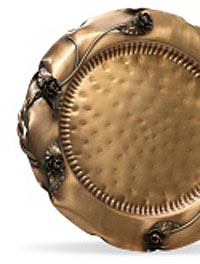The Legacy of Gregorian Copper
 Gregorian Copper Plate
Gregorian Copper PlatePhotograph courtesy of Casa Romantica
This fall, Southern Californians will be able to glimpse of a bit of metalwork history at Casa Romantica Cultural Center and Gardens, the lush estate of San Clemente founder Ole Hanson that has been turned into an historic site and performance venue. Here visitors learn about Southern California architecture, culture, ecology, and history. As part of their James Bond Casino Royale themed "Toast to the Casa" event, an annual fundraiser for the cultural center that is in its seventh year, Casa Romantica will host an exhibit of decorative and utilitarian copper works of the Gregori family.
This comprehensive copper exhibit, running through November 8, is its own "toast" to the Gregori family whose copper facility became a well-known international business during its three decades of operation in San Clemente. P. R. Gregori, the artist/founder of the company, was educated at the Butler Art Institute in Youngstown, Ohio, and after WW II received hands-on experience at Craftsman Studios at Laguna Beach, California, an artistic commune in the 1920s that evolved into a facility that produced a wealth of copper products in the Arts and Crafts style. This experience inspired Gregori and his brother Fred to start Gregori Copper in 1946. (At the same time Harry McIntosh also left to form Vermont Copper Crafters, which ceased production in 1951 due to the copper shortage during the Korean War.)
The newly formed Gregori Copper company began modestly in the garage of the Gregori brothers' parent's home in Capistrano Beach. In two short years, they were able to move into their permanent facility in San Clemente. Soon, Gregori Copper was shipping copper items all over the U.S. and to Latin America.
While Fred Gregori handled sales, P.R. Gregori not only ran the manufacturing site but was also the artist behind the copperworks. He designed all of the copper products and even made his own tools and dies. Using large sheets of copper in various gauges, Gregori fashioned utilitarian but extremely beautiful items using hand tools and even a spinning lathe. Each object was hand-beaten and finished by an acid bath. Gregori developed a special bluing process that gave each piece a depth of color and then he hand-rubbed them with steel wool, creating either a solid copper finish or a satin finish. To ensure that the copper would retain its color, it was lacquered with a gun sprayer and then baked for 40 minutes.
At the height of Gregori Copper's business, it employed 25 people and garnered annual sales of half a million dollars. In 1968, the company was sold to Sunbell, and the copperworks was eventually moved to Albuquerque, New Mexico, and continued to produce beaten copper products well into the 80s. P.R. Gregori and his wife moved to New Mexico, but soon returned to California where P.R. opened a dining establishment, Papa Pio's Italian Restaurant, in Dana Point. Sunbelt sold the company twenty years ago to a firm in Lemmon, South Dakota, that produces giftware, using various metals and resins, including delicate jewelry made with copper.
Though P.R. Gregori's legacy can still be found in private collections and some auction houses, the exquisite glory of his work is best captured in this Casa Romantica exhibit, offering a wide range of his wares. It is indeed an intimate look into a Southern California craftsman.
Resources:
Also in this Issue:
- Thinking in Metal: Sculptor Richard Hunt
- Shaping the Modern Aesthetic: Emmett Culligan Designs
- The Legacy of Gregorian Copper
- Dick Roberts: From Photography to Metal
- Frick Exhibit Features Copper Daguerreotype Photographs
